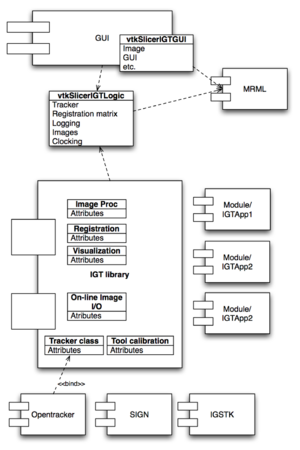Difference between revisions of "Slicer-IGT/For Developers"
| Line 33: | Line 33: | ||
'''IGT library''' is part of the library in the Lib directory of the codes. This is the library where people should contribute codes to share among IGT applications. The application specific codes should go into a '''Module'''. As a starting set of shared codes, we developed three groups of classes in the IGT library. Those are classes for interfacing to tracker and imaging devices, patient-to-image registration, and tool calibration. UML description of each group of classes can be found here. | '''IGT library''' is part of the library in the Lib directory of the codes. This is the library where people should contribute codes to share among IGT applications. The application specific codes should go into a '''Module'''. As a starting set of shared codes, we developed three groups of classes in the IGT library. Those are classes for interfacing to tracker and imaging devices, patient-to-image registration, and tool calibration. UML description of each group of classes can be found here. | ||
| − | == | + | ==Download source code and Build Slicer IGT== |
| − | |||
| − | * [[Building Slicer for IGT | Slicer3-IGT downloading and building]] | + | * [[Building Slicer for IGT | Slicer3-IGT downloading and building instruction]] |
| − | ==Version notes== | + | ===Version notes=== |
[http://www.na-mic.org/websvn/listing.php?repname=Slicer3&path=%2Fbranches%2FIGT%2F&rev=0&sc=0 SVN] | [http://www.na-mic.org/websvn/listing.php?repname=Slicer3&path=%2Fbranches%2FIGT%2F&rev=0&sc=0 SVN] | ||
| − | + | [http://www.na-mic.org/Dart/Slicer3/Dashboard/ Slicer3 Dashboard] | |
[http://www.na-mic.org/Slicer/Documentation/Slicer3/html/ Doxygen-generated documentation ] | [http://www.na-mic.org/Slicer/Documentation/Slicer3/html/ Doxygen-generated documentation ] | ||
| Line 48: | Line 47: | ||
[http://wiki.na-mic.org/Wiki/index.php/Slicer3 Slicer3 main page] | [http://wiki.na-mic.org/Wiki/index.php/Slicer3 Slicer3 main page] | ||
| − | |||
| − | |||
[http://www.na-mic.org/Slicer/Documentation/Slicer3/html/index.html Slicer 3 Documentation] | [http://www.na-mic.org/Slicer/Documentation/Slicer3/html/index.html Slicer 3 Documentation] | ||
| Line 60: | Line 57: | ||
with ADD_DEFINITIONS() it is possible to add new definitions to the gcc - commandline. Thus it is possible to influence the code compiling directly out of CMakeLists.txt. | with ADD_DEFINITIONS() it is possible to add new definitions to the gcc - commandline. Thus it is possible to influence the code compiling directly out of CMakeLists.txt. | ||
e.g.: ADD_DEFINITIONS(-DFLAGTOADD) | e.g.: ADD_DEFINITIONS(-DFLAGTOADD) | ||
| − | |||
| − | |||
Revision as of 20:27, 10 October 2007
Home < Slicer-IGT < For DevelopersBack to Slicer-IGT
Contents
Summery
‘’’Slicer for IGT’’’ is an extension of 3D Slicer designed and customized for Image Guided Therapy. 3D Slicer is comprehensive medical image processing and visualization software for medical image computing. There are many technical advantages to use Slicer for IGT research.
- Access to state of art medical image-to-image registration and segmentation algorithm
- Interface for commercial tracking device available in the market
- State-of-art patient-to-image registration methods
- Multi-platform support (Linux, Windows, Mac OS)
- Add your own software as command-line-based C or C++ program without binding it to specific toolkit or language
- Active discussion and collaboration with Image Guided Therapy researchers
- Real-time image transfer from MRI/CT/US (partially available)
- Access to tracking and registration data from a commercial navigation system (not yet available)
Objective
The objective of this page is to understand the architecture of Slicer IGT and build your own module using on Slicer.
Architecture
Inside Slicer for IGT
IGT developer should focus on writing codes in two subcomponents in Slicer: Modules and IGT library. Deteiled instruction to make your own software on the top of Slicer can be found http://wiki.na-mic.org/Wiki/index.php/Slicer3:Developers. We also provide vtkSlicerIGTLogic class in Base component of the Slicer to provide basic function for IGT applications. However, you should be working only in two most important parts (a Module and IGT library) your will be mainly adding/creating codes.
Module represents a page window in Slicer, where developers can design appliation specific GUI and associated C++ codes. The codes are usually stored in one directory under Module directory of Slicer, and self-containing for one application. One application directory have one Gui class and Logic class. Instruction to build a module can be found at How to add an interactive module.
IGT library is part of the library in the Lib directory of the codes. This is the library where people should contribute codes to share among IGT applications. The application specific codes should go into a Module. As a starting set of shared codes, we developed three groups of classes in the IGT library. Those are classes for interfacing to tracker and imaging devices, patient-to-image registration, and tool calibration. UML description of each group of classes can be found here.
Download source code and Build Slicer IGT
Version notes
Doxygen-generated documentation
Links
FAQ
HowTo
- add pre-processor flags inside CMake
with ADD_DEFINITIONS() it is possible to add new definitions to the gcc - commandline. Thus it is possible to influence the code compiling directly out of CMakeLists.txt. e.g.: ADD_DEFINITIONS(-DFLAGTOADD)
